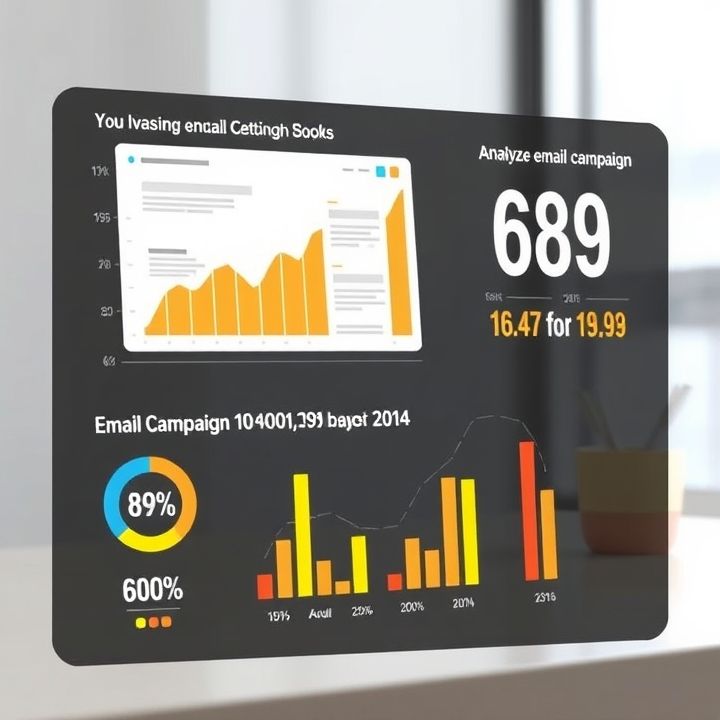Table of Contents
- Introduction
- Understanding the Synergy Between Email and Social Media Marketing
- Leveraging Social Media to Grow Your Email List
- Creating Cohesive Campaigns Across Email and Social Channels
- Analyzing Engagement Metrics from Both Email and Social Media
- Cross-Promoting Content Between Email and Social Media
- Utilizing Customer Feedback From Different Channels to Enhance Marketing Strategies
- Automating Workflows That Integrate Email and Social Media Efforts
- Case Studies of Successful Integration of Email and Social Media Marketing
- Conclusion
- Frequently Asked Questions
Introduction
Are you struggling to see the full potential of your marketing efforts? Imagine a world where email marketing, social media, and content marketing do not exist as separate entities but as a synergistic powerhouse that drives engagement and conversions. This article is your gateway to unlocking that secret sauce!
In the digital marketing realm, the integration between these platforms is not just beneficial—it’s essential. Companies that master this hybrid approach can reach wider audiences, create more personalized experiences, and see more substantial results.
| Platform | Benefits |
|---|---|
| Email Marketing | Direct and personalized communication |
| Social Media | Expands reach and engagement |
| Content Marketing | Offers value and builds authority |
So, how can you combine these powerful strategies to create a seamless and effective marketing campaign? Continue reading to discover expert tips, real-world examples, and actionable insights that will revolutionize your marketing game.
Understanding the Synergy Between Email and Social Media Marketing
Understanding the synergy between email and social media marketing is crucial for any comprehensive marketing strategy. Each channel has its unique strengths, and when combined, they can significantly amplify your marketing efforts. Email marketing provides a direct line of communication with your audience, offering personalized content and exclusive promotions. Social media, on the other hand, is excellent for reach, engagement, and community building.
Integrating the two can start with leveraging social media to grow your email list. Promote your newsletter across your social platforms to encourage followers to subscribe. You can also use social media ads with a call-to-action that directs users to sign up for your emails. Conversely, include social media buttons in your email campaigns to drive traffic to your social profiles. This not only increases your followers but also promotes sharing of your content, expanding your reach.
Another effective strategy is to use email campaigns to highlight your social media content. Featuring top social media posts in your newsletters can drive email subscribers to your social channels. This cross-promotion ensures consistent messaging and maximizes your content’s impact across different platforms.
Leveraging Social Media to Grow Your Email List
Leveraging social media to grow your email list is a highly effective strategy that marries the best of both platforms. To begin with, you can use social media channels to promote exclusive content or offers that are only available through email subscriptions. For example, you can create a compelling call-to-action in your posts, urging followers to join your email list to receive special discounts, ebooks, or insider updates.
Using social media advertisements is another powerful tactic. Platforms like Facebook, Instagram, and LinkedIn offer targeting options that allow you to reach a specific audience. By running ads that promise valuable content or offers in exchange for an email subscription, you can attract high-quality leads.
Social media contests and giveaways are also excellent for list building. By asking participants to sign up through their email addresses, you turn engagement into subscriptions. Lastly, ensure that your social media profiles and pages include easy-to-find links to your email sign-up forms. This consistent visibility will remind visitors and followers to subscribe to your list, thereby seamlessly integrating your email marketing with your social media efforts.
Creating Cohesive Campaigns Across Email and Social Channels
Creating cohesive campaigns across email and social channels involves strategic planning and consistent messaging. To start, it’s essential to align your email marketing objectives with your social media goals. This means ensuring that the content, tone, and visuals are consistent across both platforms. For instance, if you are launching a new product, your email campaign should mirror the messaging and imagery used in your social media posts. This creates a unified experience for your audience, regardless of the platform they are using.
Another important aspect is leveraging the strengths of each channel. Email can deliver more detailed content directly to your subscribers’ inboxes, whereas social media is excellent for real-time engagement and reaching a broader audience. Use social media to drive traffic to your email sign-up forms, or use email newsletters to promote your social media channels and special campaigns.
Integrated analytics also play a crucial role. By tracking the performance of both your email and social campaigns, you can gain insights into what resonates with your audience and adjust your strategies accordingly. This data-driven approach ensures that your campaigns are more effective and cohesive, ultimately driving better results.
Analyzing Engagement Metrics from Both Email and Social Media
Analyzing engagement metrics from both email and social media is crucial for understanding the effectiveness of your marketing strategy. First, look at open rates and click-through rates in your email campaigns. These metrics tell you how many recipients opened your email and engaged with the content inside. Pair this data with social media metrics such as likes, shares, comments, and engagement rates to get a holistic view of how your audience interacts across different platforms.
It’s also essential to track conversion rates from both channels. This means linking email campaigns and social media posts to specific landing pages with unique tracking URLs. Analyzing which platform drives more traffic and sales can help you allocate your marketing budget more efficiently.
Another key aspect is to measure the sentiment of engagement. While emails might show high open rates, the sentiment in the responses or actions taken afterward may differ from the engagement you receive on social media. Tools like sentiment analysis can help you understand the mood and reaction of your audience towards your communications.
By regularly comparing these metrics, you can optimize your campaigns to increase engagement, improve customer satisfaction, and ultimately drive better results for your business.
Cross-Promoting Content Between Email and Social Media
Cross-promoting content between email and social media is an effective way to maximize the reach and impact of your marketing efforts. By integrating these channels, you can reinforce your message and engage your audience on multiple platforms. Start by promoting your social media profiles in your email newsletters. Include social media icons and encourage subscribers to follow or share your content. This not only increases your social media following but also enhances the likelihood of your content being shared beyond your immediate network.
Conversely, you can use your social media channels to grow your email list. Share compelling snippets of your email content on platforms like Facebook, Twitter, and Instagram, and include a call-to-action that directs users to sign up for your email newsletter. This provides an incentive for social media followers to subscribe, giving you a more direct line of communication with them.
Additionally, consider running exclusive promotions or contests that span both platforms. For instance, you could announce a giveaway on social media but require users to subscribe to your email list to enter. This not only drives email sign-ups but also creates a sense of community and excitement among your audience.
Utilizing Customer Feedback From Different Channels to Enhance Marketing Strategies
Utilizing customer feedback from different channels is crucial to refining and enhancing your marketing strategies. Listening to what customers say through various platforms like social media, email surveys, and website comments provides valuable insights into their needs and preferences. Integrating this feedback allows you to tailor your marketing efforts to better align with customer expectations.
Start by monitoring feedback across all channels. Social media is a goldmine for real-time reactions and sentiments, while email surveys can offer more in-depth understanding. Use analytics tools to aggregate and analyze this data, identifying common patterns and recurring themes.
Once you have gathered feedback, integrate it into your marketing strategy. For example, if customers frequently mention a need for more personalized content, this insight can guide your email marketing campaigns and social media posts. By aligning your strategies with customer feedback, you not only improve customer satisfaction but also strengthen customer loyalty and engagement.
Finally, it’s important to keep the feedback loop open. Regularly seek customer opinions and show them that their insights are valued and acted upon. This ongoing dialogue helps in continuously evolving your strategies to meet changing customer needs.
Automating Workflows That Integrate Email and Social Media Efforts
Automating workflows that integrate email and social media efforts can significantly enhance your marketing efficiency and reach. By linking these two powerful channels, you can create a cohesive strategy that maximizes your engagement opportunities. Automation tools allow you to schedule social media posts that coincide with your email campaigns. For instance, you can set up triggers that automatically post snippets or teasers of your email content on your social media platforms. This not only broadens the reach of your message but also provides multiple touchpoints for your audience.
Moreover, you can use analytics tools to track the performance of integrated campaigns, helping you to tailor future content more precisely. Segmenting your email list based on social media interactions can offer more personalized messaging, thus increasing conversion rates. Automation also enables you to conduct A/B testing more efficiently across different channels, ensuring that your strategies are fine-tuned for optimal results.
In summary, automating the integration of email and social media efforts allows for a more synchronized and potent marketing approach. It saves time, reduces manual work, and ensures that your brand message remains consistent across all channels.
Case Studies of Successful Integration of Email and Social Media Marketing
Case studies of successful integration of email and social media marketing often highlight the synergy between these two powerful channels. One notable example is the clothing brand GAP, which expertly utilized its email marketing list to boost social media engagement. By including social sharing buttons and inviting email recipients to follow their social media profiles, GAP significantly increased their followers and engagement rates on platforms like Instagram and Facebook.
Another successful case is Airbnb, which leverages user-generated content from social media in their email campaigns. By integrating captivating posts, images, and reviews from their social media platforms into their email newsletters, Airbnb creates a more authentic and engaging experience for their subscribers. This strategy not only enhances email content but also encourages subscribers to share their experiences on social media, creating a virtuous cycle of engagement.
Additionally, the cosmetics brand Sephora has advanced this integration by coordinating their email promotions with social media ad campaigns. This synchronized approach ensures that the message is consistent across all channels, reinforcing their marketing efforts and driving higher conversion rates. By studying these examples, businesses can gain valuable insights into effectively merging email and social media marketing to amplify their reach and impact.
Conclusion
Mastering the integration of email marketing with social media and content marketing is a game-changer for any business looking to boost its engagement and conversion rates. By understanding the synergy between these channels, leveraging social media to grow your email list, and creating cohesive campaigns, you can maximize your marketing impact. Analyzing engagement metrics and utilizing customer feedback provide invaluable insights to refine your strategies further. Cross-promoting content and automating workflows not only enhance efficiency but also ensure consistent messaging across all platforms. Case studies like those of GAP, Airbnb, and Sephora demonstrate the tangible benefits of such integration, offering inspiration and practical lessons. By implementing these best practices, you can unlock the full potential of your marketing efforts, drive better results, and build stronger relationships with your audience.

